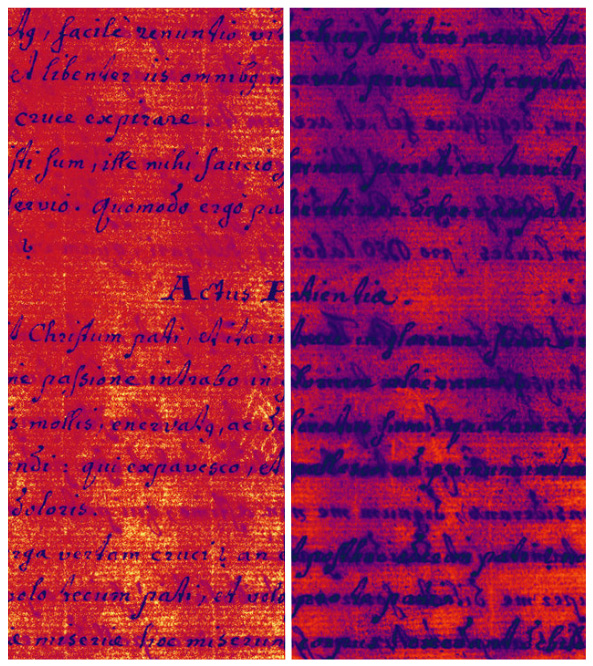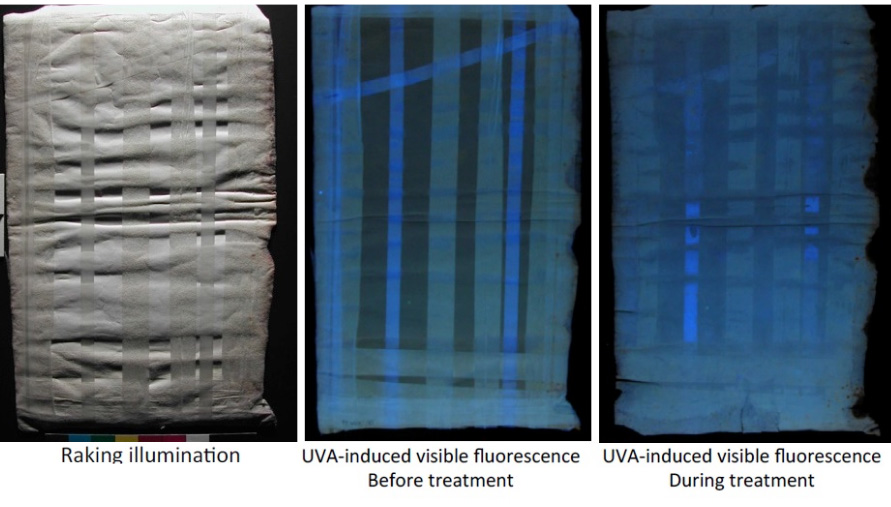At the beginning of March, the multispectral imaging working group presented details about the imaging system and the group’s progress so far to other library staff at a First Wednesday event. Representatives from Conservation Services, Data and Visualization Services, the Digital Production Center, the Duke Collaboratory for Classics Computing (DC3) and the Rubenstein Library each shared their involvement and interest in the imaging technology. Our presentation attempted to answer some basic questions about how the equipment works and how it can be used to benefit the scholarly community. You can view a video of that presentation here.
![]()
Some of the images we have already shared illustrate a basic benefit or goal of spectral imaging for books and manuscripts: making obscured text visible. But what else can this technology tell us about the objects in our collections? As a library conservator, I am very interested in the ways that this technology can provide more information about the composition and condition of objects, as well as inform conservation treatment decisions and document their efficacy.
Conservators and conservation scientists have been using spectral imaging to help distinguish between and to characterize materials for some time. For example, pigments, adhesives, or coatings may appear very differently under ultraviolet or infrared radiation. Many labs have the equipment to image under a few wavelengths of light, but our new imaging system allows us to capture at a much broader range of wavelengths and compare them in an image stack.

Spectral imaging can help to identify the materials used to make or repair an object by the way they react under different light sources. Correct identification of components is important in making the best conservation treatment decisions and might also be used to establish the relative age of a particular object or to verify its authenticity. While spectral imaging offers the promise of providing a non-destructive tool for identification, it does have limitations and other analytical techniques may be required.

Multispectral imaging offers new opportunities to evaluate and document the condition of objects within our collections. Previous repairs may be so well executed or intentionally obscured that the location or extent of the repair is not obvious under visible light. Areas of paper or parchment that have been replaced or have added reinforcements (such as linings) may appear different from the original when viewed under UV radiation. Spectral imaging can provide better visual documentation of the degradation of inks ( see image below) or damage from mold or water that is not apparent under visible light.

This imaging equipment provides opportunities for better measuring the effectiveness of the treatments that conservators perform in-house. For example, a common treatment that we perform in our lab is the removal of pressure sensitive tape repairs from paper documents using solvents. Spectral imaging before, during, and after treatment could document the effectiveness of the solvents or other employed techniques in removing the tape carrier and adhesive from the paper.

Staff from the Conservation Services department have a long history of participating in the library’s digitization program in order to ensure the safety of fragile collection materials. Our department will continue to serve in this capacity for special collections objects undergoing multispectral imaging to answer specific research questions; however, we are also excited to employ this same technology to better care for the cultural heritage within our collections.
______
Want to learn even more about MSI at DUL?
- Watch an imaging Session
- Read other MSI posts on Duke Libraries’ Bitstreams and Preservation Underground blogs


